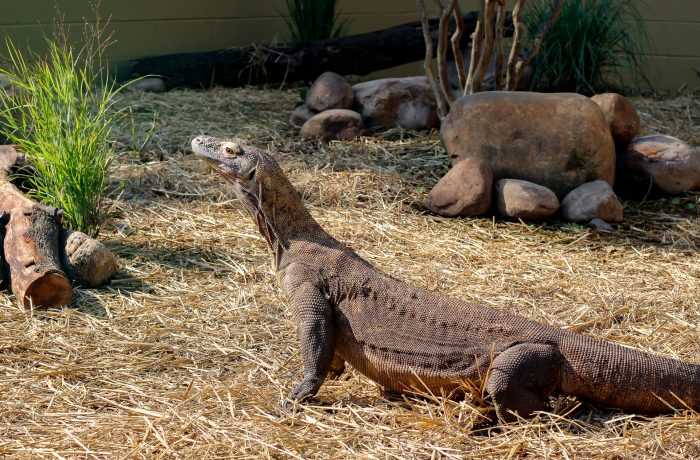In 2019, herpetologists from the Chattanooga Zoo in Tennessee contacted Pisces with an interesting question. Their female Komodo Dragon (Varanus komodoensis), Charlie, had laid three eggs, which the zoo successfully incubated. Now they wondered if the three baby Dragons were the offspring of Charlie and Kadal, the zoo’s resident male Komodo, or if they were the product of parthenogenesis (virgin birth) or long-term sperm storage.
Parthenogenesis is extremely rare, but not unheard of in monitor lizards (genus Varanus). In 2006, two female Komodo Dragons at different zoos in England were reported to have had eight and four babies, respectively, without any contact with males. Charlie and Kadal had been introduced to each other, but their caretakers did not believe they had ever mated. There was a possibility that sperm stored long-term in Charlie could have fertilized her eggs, but the only other option was parthenogenesis.
Could Pisces use DNA testing to settle the matter?
By comparing microsatellite markers in the hatchling Dragons with those of their mother, we determined that Charlie’s brood was, indeed, a case of parthenogenesis. The genotypes of other potential male mates were not available making it impossible to absolutely exclude the possibility that the three baby Komodo Dragons were the result of long-term sperm storage; however, the genotypes of the hatchlings (two were homozygous for three of the microsatellite loci that their mother was heterozygous for) made this statistically very unlikely.
After this conclusion, the Chattanooga Zoo had another question: What was the sex of the three offspring?
Reptiles are notoriously difficult to sex; they do not typically have obvious external genitalia, especially when young. The Chattanooga Zoo is part of the Komodo Dragon Species Survival Plan (SSP), administered by the Association of Zoos and Aquariums (AZA). The SSP coordinates the breeding of Komodos in captivity at participating zoos. Zoos frequently swap specimens in order to have breeding pairs and ensure the genetic diversity of captive-bred animals. Moving specimens like Komodos from zoo to zoo is far easier when they are young and small—but researchers have to know their sex.
Halvorsen & Spelman and Sulandri et al developed a PCR-based assay for sexing V. komodoensis which utilized primers giving a different banding pattern in males and females. However, the assay was tedious due to the requirement for careful resolution of very closely spaced amplified bands via agarose gel electrophoresis. Our solution to improve the assay was to use a SYBR Green qPCR melt assay: We found that the male and female Komodo DNA fragments amplified by the assay had different melting peaks that clearly identified samples as one or the other sex. Using the melt curve assay also eliminated the need for agarose gel electrophoresis, which cut the assay time in half. We were able to use this assay with DNA extracted from a drop of blood from the hatchlings to determine that all three hatchlings were male. This also confirmed that the hatchlings were of parthenogenic origin. Komodo Dragon sex chromosomes are W and Z, not the familiar human X and Y. Female Komodos are heterozygous ZW, and males are homozygous ZZ. Because all the genetic material for each parthenogenetic hatchling came from an unfertilized egg, they all had to be either WW or ZZ. Because WW eggs are not viable, only ZZ eggs—males—survive.
But the story didn’t end there. Other zoos involved in the Komodo Dragon SSP heard about the work we had done for the Chattanooga Zoo. So, not long after, we received an inquiry from the Honolulu Zoo: Will the assay work on another type of monitor lizard, the Crocodile Monitor? Yes, the assay worked on Crocodile Monitors. Next, the Oklahoma Zoo contacted us asking if the assay would work on Black Tree Monitors—and again, it did. Presently, we believe that the assay is likely generalizable to all monitor lizards and possibly to other lizards and reptiles as well. Although the assay was developed in support of Komodo Dragon conservation efforts, it has already proven to be valuable to herpetologists working with other monitor lizard species (genus Varanus) as well.
The assay is also of interest for reptile breeders and enthusiasts, especially for those who breed lizards. If you are able to provide samples for testing from known-sex animals of other lizard species, please contact us!
References:
Sulandari, S., Zein, M.S.A., Arida, E.A., Hamidy, A. (2014): Molecular Sex Determination of Captive
Komodo Dragons (Varanus Komodoensis) at Gembira Loka Zoo, Surabaya Zoo, and Ragunan Zoo, Indonesia. Hayati Journal of Biosciences 21 (2): 65-75.
Halverson, J., Spelman, L.H. (2002): Sex Determination and Its Role in Management. In: Murphy, J. B.,
Ciofi, C., De La Panouse C., Walsh, T. (Eds). Komodo Dragons: Biology and Conservation.
Smithsonian Institution Press, Washington, P. 165-177.

